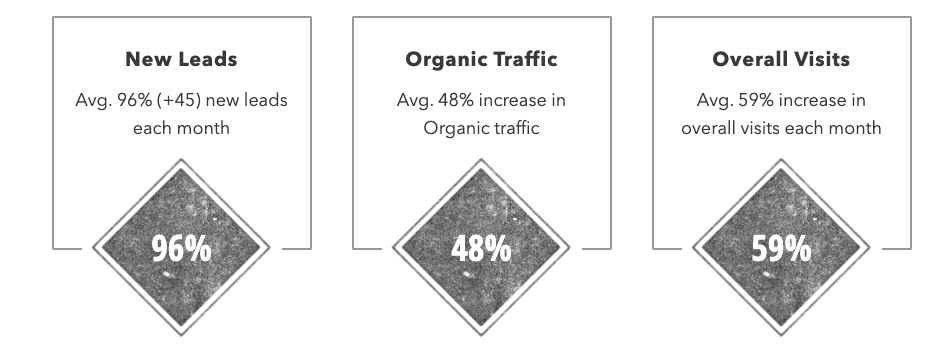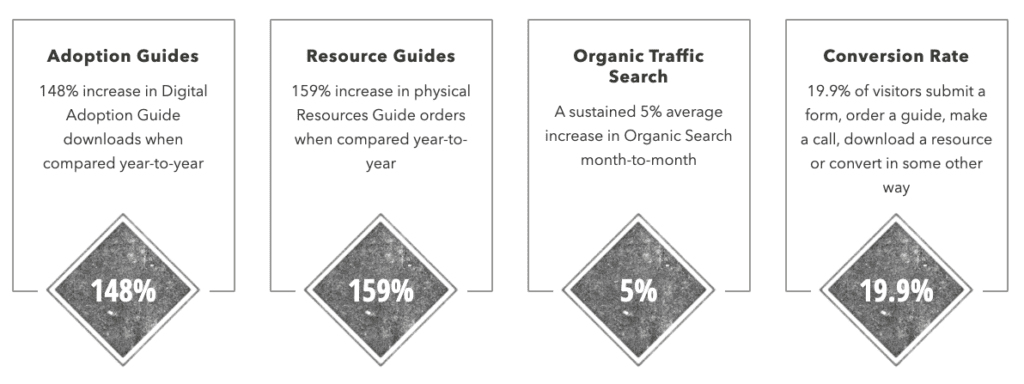
On-Page SEO Best Practices – Outrank Your Competitors
Better SEO Strategies Are More Likely To Convert Leads
Search engine optimization (SEO) tips and tricks? Please. A simple Google search shows countless articles, blogs, and websites claiming to increase organic traffic, boost your sales, and ultimately claiming to help you make more money.
The thing is, nothing is guaranteed when it comes to SEO. And anyone who promises you a certain ROI amount or percentage increase is lying.
The real SEO experts here at ForeFront keep things transparent. We know and understand that SEO best practices are always changing, simply because the way search engines pull content is constantly evolving. We won’t guarantee anything other than we’re using the best (and most current) techniques and strategies to attract quality traffic. Simple as that.
Except… it’s not always so simple. Optimizing your website to outrank your competitors takes a lot of research, grunt work, and understanding of how the Google gods function. The process can get complex quite quickly. Instead of boring you with the nerdy stuff (like Core Web Vitals, RankBrain, and the value of aged links vs. fresh ones), we decided to put our money where our mouth is and show you how we’ve helped our clients shut out their competition with perfected on-page SEO.
Let’s Start With the SEO Basics
If you’re wondering what on-page SEO is and how it differs from generalized SEO, you’re not alone. Let’s go over some of the general info before jumping into nitty-gritty tactics and industry-specific SEO case studies.
What Is On-Page SEO?
On-page SEO, otherwise known as on-site SEO, is a subcategory of search engine optimization. It consists of collectively improving a web page with keywords, links, valuable information, and coding love to catch the attention of Google, Bing, and the rest of the search engines out there. Your on-page SEO approach should aim to help bots crawl your website in a way that ranks you higher than the rival competition – both from an expertise standpoint as well as page load speeds.
If you have a hunch your SEO isn’t working, you’re in the right place. No matter if you’re overseeing a healthcare practice, a nonprofit, or anything in between, SEO should be a foundational element in your digital marketing strategy.
On-Page SEO for Healthcare
Columbus, Ohio is full of healthcare professionals and organizations, all vying for top positions in the Google trenches. A common problem we see when working with a healthcare and/or medical client is they have so much information about the services they provide, they often lose sight of the user experience. They may find themselves writing an autobiography when really they should be writing a “how-to.”
When our paths crossed with Magnolia Dental, their website wasn’t doing much to generate traffic or show in search results. It was outdated, lacked content and the mobile experience left much to be desired.
Like most healthcare providers, they needed to show up in new cities to break into fresh markets. It became clear they needed to not only increase organic traffic but implement an entire content marketing strategy for their dental practice.
We started with on-page SEO on their old site. Adding our SEO special sauce to content, we sprinkled their services page our most trusted (and proven) tactics:
- Keywords – Not just any keywords, keywords that people actually use on a daily basis, backed by real data using elite tools like Moz and Semrush.
- Header hierarchy – No, you shouldn’t have H1 tags multiple times throughout the same page.
- 301 redirects – Those nasty broken links that lead to tacky 404 pages? Clean ‘em up!
- Concise Calls-To-Action – because people like being told what to do.
Healthcare SEO Results
Magnolia Dental’s initial project consisted of on-page SEO, some off-site backlinking, and website improvements. The final results are as stunning as the smiles they treat.

Want the full scoop? Contact us to see what results we can get for you.
On-Page SEO for Nonprofits
SEO best practices don’t always come easy, especially for nonprofits – but they can come cheap; you just have to put the time in for the cause. ForeFront believes in giving back to the community in any way we can, and it just so happens that we can use our expertise to help these excellent organizations reach more people. Partnering with an amazing nonprofit like The Dave Thomas Foundation was so much more than a digital marketing project to us. It was a chance to help children in foster care find loving families.
Not only did this client need a new website, but also content that appeased search engines, messaging that attracted the people they were targeting, and a system for tracking downloads/on-site conversions. We wanted to show up in searches right away, so our SEO team tweaked content on their old website to help both Google bots and potential families consume their information easier. An easier user experience means a higher chance of showing up in search results and thus converting
Traffic picked up after we added on-page SEO love:
- Benchmarking reports – this helps us know where the project is starting at and what we need to do to reach our goals.
- Creative messaging + SEO-ranking keywords – using long-tail keywords in both headlines and content.
- Pictures – a picture is worth a thousand words, but pictures with optimized alt. text behind them are worth a lot more.
Nonprofit SEO Results
We love a happy ending, but our work with The Dave Thomas Foundation (and all of our SEO clients) is ongoing! Our on-page SEO, off-page SEO, and website design are still reaping the benefits for this beloved client.

It’s all in a day’s work for our SEO experts!
How to Rank Higher in Search Results with On-Page SEO
Outshining the competition in a Google search takes a solid understanding of how bots crawl your website. More so, you have to know how to use Google’s criteria to your advantage when creating or optimizing your web content. The moment you start identifying weaknesses in your competition’s web presence is the moment you start winning!
We’ve highlighted a few of our most trusted tactics to boost your on-page SEO. If you’re feeling strong about your website, consider the list below as a sort of checklist. It doesn’t hurt to check your content twice, even three times to make sure you’re outranking your rivals.
Use Keywords Strategically
Before writing anything, ask yourself what keywords you want to rank for. Are these words and phrases people are actually using to find similar services, or are these just the phrases you want people to associate with your business? Using tools like Google Ads Keyword Planner, Moz, or even just Google Autofill can help you get started.
After you have a list of keywords and keyword variations, you can write your web page content with these keywords sprinkled throughout the page. We’ll leave you with one last tip: use keywords in your headers. Page titles. Title tags. The bigger words on a page. Whatever you call them – Google LOVES this.
Pay Attention to Meta Descriptions
If you’re working in a CMS (like WordPress), adding or optimizing meta descriptions can make a world of difference for your on-page SEO. Treat meta descriptions like a brief explanation of what your page is about. Using keywords is a plus, but try to keep it short and sweet – like an elevator pitch. The plugin “Yoast SEO” makes this significantly easier for you.
Lean on Header Hierarchies to Make Your Content Easy to Crawl and Consume
Did you know you should only have one H1 tag per page? Apply H1 tags to the page’s title and that’s it. Use H2, H3, and even H4 tags to help guide the user or bot through your web page. Here’s what we mean:
- H1: page title
- H2: page subtitle
- H3: page sub-subtitle (think service descriptions and subcategories)
- H4: anything else that may need a header tag like a CTA at the end of the page
Image Alt Text Always
Using pictures or graphics on your website is a great way to help communicate your message to the world while breaking up text. It keeps readers engaged (since scrolling is inevitable) and interested in your content. You can use images to improve on-page SEO by leveraging something called image alt text. Alt text helps bots read what your image is, which comes in handy if the image is loading slowly. Keep it simple and describe what the image actually is. If you see an opportunity to naturally use a keyword in the description you should definitely do so.
The Never-Ending Question: How Many Words Do I Need?
By now, most people realize that Google will likely overlook pages with “thin content” – pages with less than “x” number of words. Experts disagree on the actual number, but here at ForeFront, we know the answer.
If you’re trying to create a page on your site that ranks well for a certain phrase, the number of words you need on that page is…wait for it…as many as it takes.
I know, it sounds like a big cop-out. But it’s true, and here’s what we mean. If you want to rank for an obscure phrase like “fat purple unicorn”, well, you could probably just put that phrase in a page that even has thin content and you’ll start to rank for it. But if you’re going for something highly competitive like “medical supply carts”, you’ll likely need 1,500 or more. And the more competitive the phrase, the more content you’ll probably need.
So how do you/we actually know how many words we’ll need? Well, now you get into the super fun area of SEO research. The simple way is to use a site crawler (like Screaming Frog – yes, that’s a thing), crawl a competitor site, and get a sense of how many words are on all their high-ranking pages. Do the same for all your other competitors, and there’s your baseline. Now all you have to do is figure out a way to write thousands of words and make it interesting. Ready to become an SEO analyst yet?
While There Are Some Constants, SEO Best Practices Never Stop Evolving
Google and other search engines must continue to change how they pull data in search results as they try to give the best answers to the most pressing user questions. If they aren’t retrieving relevant information, people will lose trust and look for alternatives – which isn’t great for ad revenue. On-page SEO is an amazing set of tools that can improve your chances of first-page rankings by using your current website and Google’s incessant need to always improve its algorithm.
When you beef up your digital marketing strategy with SEO techniques, you’ll quickly realize how effective keywords, meta descriptions and comprehensive web copy can be – it just takes time and some added effort. If you put in that extra effort to create the best answers and user experience, it improves your odds of ranking higher and bringing in more business.
Just remember: SEO is always changing and there’s no guarantee that you’ll get X number of leads just from using a single SEO practice. You can always contact your digital marketing experts if you feel stuck.
Get a Free Website Analysis
Not sure where your website stands in a sea of competition? ForeFront Web has an arsenal of SEO tools and digital marketing pros who live and breathe this stuff every day. If you think you’re missing out on potential traffic and easy search rankings, we’re here to help. Your free website analysis is created by real humans – and you won’t end up on some marketing automation list!
